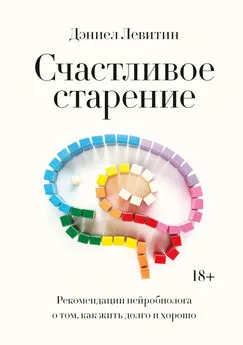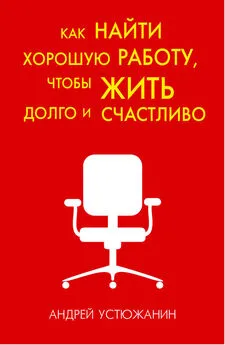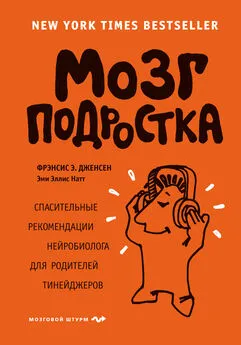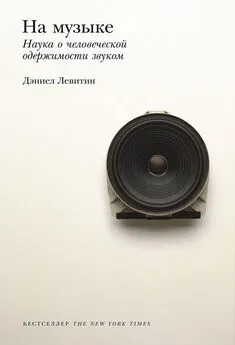Дэниел Левитин - Счастливое старение. Рекомендации нейробиолога о том, как жить долго и хорошо
- Название:Счастливое старение. Рекомендации нейробиолога о том, как жить долго и хорошо
- Автор:
- Жанр:
- Издательство:Манн, Иванов и Фербер
- Год:2021
- Город:Москва
- ISBN:9785001695868
- Рейтинг:
- Избранное:Добавить в избранное
-
Отзывы:
-
Ваша оценка:
Дэниел Левитин - Счастливое старение. Рекомендации нейробиолога о том, как жить долго и хорошо краткое содержание
Ответы на эти и многие другие вопросы вы найдете в книге известного нейробиолога и автора бестселлеров о природе возрастных изменений и о том, как можно прожить долго и что нужно делать сейчас (в любом возрасте), чтобы в 70, 80 и 90 жить полной жизнью.
Книга предназначена для широкого круга читателей.
На русском языке публикуется впервые.
Счастливое старение. Рекомендации нейробиолога о том, как жить долго и хорошо - читать онлайн бесплатно ознакомительный отрывок
Интервал:
Закладка:
123
M. Bedny, H. Richardson, and R. Saxe, “ ‘Visual’ Cortex Responds to Spoken Language in Blind Children,” Journal of Neuroscience 35, no. 33 (2015): 11674–11681; B. Röder et al., “Speech Processing Activates Visual Cortex in Congenitally Blind Humans,” European Journal of Neuroscience 16, no. 5 (2002): 930–936.
124
M. Sur, P. E. Garraghty, and A. W. Roe, “Experimentally Induced Visual Projections into Auditory Thalamus and Cortex,” Science 242, no. 4884 (1988): 1437–1441; S. L. Pallas, A. W. Roe, and M. Sur, “Visual Projections Induced into the Auditory Pathway of Ferrets. I. Novel Inputs to Primary Auditory Cortex (AI) from the LP/Pulvinar Complex and the Topography of the MGN-AI Projection,” Journal of Comparative Neurology 298, no. 1 (1990): 50–68.
125
A. L. de Dieuleveult et al., “Effects of Aging in Multisensory Integration: A Systematic Review,” Frontiers in Aging Neuroscience 9 (2017): 80, http://dx.doi.org/10.3389/fnagi.2017.00080.
126
A. Shimamura, Get SMART! Five Steps toward a Healthy Brain (Scotts Valley, CA: CreateSpace, 2017).
127
R. Peters, “Ageing and the Brain,” Postgraduate Medical Journal 82, no. 964 (2006): 84–88; R. Rutledge et al., “Risk Taking for Potential Reward Decreases across the Lifespan,” Current Biology 26, no. 12 (2016): 1634–1639.
128
M. Kubota et al., “Alcohol Consumption and Frontal Lobe Shrinkage: Study of 1432 Non-Alcoholic Subjects,” Journal of Neurology, Neurosurgery and Psychiatry 71, no. 1 (2001): 104–106; X. Yang et al., “Cortical and Subcortical Gray Matter Shrinkage in Alcohol-Use Disorders: A Voxel-Based Meta-Analysis,” Neuroscience and Biobehavioral Reviews 66 (2016): 92–103.
129
A. M. Hedman et al., “Human Brain Changes across the Life Span: A Review of 56 Longitudinal Magnetic Resonance Imaging Studies,” Human Brain Mapping 33, no. 8 (2012): 1987–2002.
130
Peters, “Ageing and the Brain.”
131
Shimamura, Get SMART!.
132
M. Balter, “The Incredible Shrinking Human Brain,” Science, July 25, 2011, http://www.sciencemag.org/news/2011/07/incredible-shrinking-human-brain; C. C. Sherwood et al., “Aging of the Cerebral Cortex Differs between Humans and Chimpanzees,” Proceedings of the National Academy of Sciences 108, no. 32 (2011): 13029–13034.
133
R. Buckner, J. Andrews-Hanna, D. Schacter, “The Brain’s Default Network: Anatomy, Function, and Relevance to Disease,” Annals of the New York Academy of Sciences 1124, no. 1 (2008): 1–38.
134
S. Gauthier et al., “Mild Cognitive Impairment,” Lancet 367, no. 9518 (2006): 1262–1270.
135
Gauthier et al., “Mild Cognitive Impairment.”
136
R. C. Petersen, “Mild Cognitive Impairment,” Continuum: Lifelong Learning in Neurology 22, no. 2, Dementia (2016): 404.
137
B. C. M. Stephan et al., “The Neuropathological Profile of Mild Cognitive Impairment (MCI): A Systematic Review,” Molecular Psychiatry 17, no. 11 (2012): 1056.
138
R. C. Petersen et al., “Mild Cognitive Impairment: A Concept in Evolution,” Journal of Internal Medicine 275, no. 3 (2014): 214–228.
139
L. Qian et al., “Intrinsic Frequency Specific Brain Networks for Identification of MCI Individuals Using Resting-State fMRI,” Neuroscience Letters 664 (2018): 7–14.
140
Представление об «избыточности» нервных элементов мозга возникло в 1960-х. Подробнее об этом см. Белкин П.Г. «Избыточность» мозга и концептуальные модели в нейрофизиологии // Институт истории естествознания и техники им. С.И. Вавилова. Годичная научная конференция, 2002. М.: Диполь-Т, 2002. Прим. ред.
141
Y. Stern, “Cognitive Reserve in Ageing and Alzheimer’s Disease,” Lancet Neurology 11, no. 11 (2012): 1006–1012; Y. Stern, “Cognitive Reserve: Implications for Assessment and Intervention,” Folia Phoniatrica et Logopaedica 65, no. 2 (2013): 49–54; H. Amieva et al., “Compensatory Mechanisms in Higher-Educated Subjects with Alzheimer’s Disease: A Study of 20 Years of Cognitive Decline,” Brain 137, no. 4 (2014): 1167–1175.
142
Shimamura, Get SMART!.
143
P. Belluck, “Will We Ever Cure AD?” The New York Times, November 19, 2018, p. D6.
144
P. Eikelenboom and R. Veerhuis, “The Importance of Inflammatory Mechanisms for the Development of Alzheimer’s Disease,” Experimental Gerontology 34, no. 3 (1999): 453–461.
145
P. L. McGeer, J. Rogers, and E. G. McGeer, “Inflammation, Anti-inflammatory Agents, and Alzheimer’s Disease: The Last 22 Years,” Journal of Alzheimer’s Disease 54, no. 3 (2016): 853–857.
146
N. Brouwers, K. Sleegers, and C. Van Broeckhoven, “Molecular Genetics of Alzheimer’s Disease: An Update,” Annals of Medicine 40, no. 8 (2008): 562–583; A. Pink et al., “Neuropsychiatric Symptoms, APOE ε4, and the Risk of Incident Dementia: A Population-Based Study,” Neurology 84, no. 9 (2015): 935–943.
147
Y. Y. Lim, E. C. Mormino, and Alzheimer’s Disease Neuroimaging Initiative, “APOE Genotype and Early β-Amyloid Accumulation in Older Adults without Dementia,” Neurology 89, no. 10 (2017): 1028–1034.
148
“Dr John Zeisel: Looking at Dementia with Hope,” posted by Jewish Home Life Communities, June 20, 2018, https://www.youtube.com/watch?v=Ze1WyCh_5zQ.
149
G. Livingston et al., “Dementia Prevention, Intervention, and Care,” Lancet 390, no. 10113 (2017): 2673–2734.
150
Associated Press, “Low-Dose Aspirin Too Risky for Most People, Studies Find,” NBC News, August 27, 2018, https://www.nbcnews.com/health/heart-health/low-dose-aspirin-too-risky-most-people-studies-find-n904281.
151
European Society of Cardiology, “Jury Still Out on Aspirin a Day to Prevent Heart Attack and Stroke,” ScienceDaily, August 26, 2018, www.sciencedaily.com/releases/2018/08/180826120759.htm.
152
J. Rée, “The Brain’s Way of Healing: Stories of Remarkable Recoveries and Discoveries by Norman Doidge – Review,” The Guardian, January 23, 2015, https://www.theguardian.com/books/2015/jan/23/the-brains-way-healing-stories-remarkable-recoveries-norman-doidge-review; N. Doidge, The Brain’s Way of Healing: Stories of Remarkable Recoveries and Discoveries (London: Penguin UK, 2015).
153
A. Zuger, “The Brain: Malleable, Capable, Vulnerable,” The New York Times, May 29, 2007, https://www.nytimes.com/2007/05/29/health/29book.html.
154
S. M. Ryan and Y. M. Nolan, “Neuroinflammation Negatively Affects Adult Hippocampal Neurogenesis and Cognition: Can Exercise Compensate?” Neuroscience and Biobehavioral Reviews 61 (2016): 121–131.
155
O. Bergmann, K. L. Spalding, and J. Frisén, “Adult Neurogenesis in Humans,” Cold Spring Harbor Perspectives in Biology 7, no. 7 (2015): a018994.
156
S. F. Sorrells et al., “Human Hippocampal Neurogenesis Drops Sharply in Children to Undetectable Levels in Adults,” Nature 555, no. 7696 (2018): 377.
157
M. Boldrini et al., “Human Hippocampal Neurogenesis Persists throughout Aging,” Cell Stem Cell 22, no. 4 (2018): 589–599.
158
S. C. Danzer, “Adult Neurogenesis in the Human Brain: Paradise Lost?” Epilepsy Currents 18, no. 5 (2018): 329–331; G. Kempermann et al., “Human Adult Neurogenesis: Evidence and Remaining Questions,” Cell Stem Cell 23, no. 1 (2018): 25–30.
159
Из личного общения с Мари Кодама 25 декабря 2016 года.
160
R. W. Berkowsky, J. Sharit, and S. J. Czaja, “Factors Predicting Decisions about Technology Adoption among Older Adults,” Innovation in Aging 1, no. 3 (2018): igy002; T. L. Mitzner et al., “Technology Adoption by Older Adults: Findings from the PRISM Trial,” Gerontologist 59, no. 1 (2018): 34–44.
161
Vision Council Research, “U.S. Optical Overview and Outlook,” December 2015, https://www.thevisioncouncil.org/sites/default/files/Q415-Topline-Overview-Presentation-Stats-with-Notes-FINAL.PDF.
162
W. Chien and F. R. Lin, “Prevalence of Hearing Aid Use among Older Adults in the United States,” Archives of Internal Medicine 172, no. 3 (2012): 292–293.
163
L. Rapoport, “Hearing Aids Tied to Less Hospitalization for Older U.S. Adults,” Reuters, May 9, 2018, https://www.reuters.com/article/us-health-hearing/hearing-aids-tied-to-less-hospitalization-for-older-u-s-adults-idUSKBN1IA2ZR.
164
I. Kohler, “Experiments with Goggles,” Scientific American 206, no. 5 (1962): 62–73.
165
S. P. Johnson and E. E. Hannon, “Perceptual Development,” Handbook of Child Psychology and Developmental Science 2 (2015): 63–112; L. G. Craton, “The Development of Perceptual Completion Abilities: Infants’ Perception of Stationary, Partially Occluded Objects,” Child Development 67, no. 3 (1996): 890–904; B. S. Hadad and R. Kimchi, “Perceptual Completion of Partly Occluded Contours during Childhood,” Journal of Experimental Child Psychology 167 (2018): 49–61.
166
H. E. F. von Helmholtz, Treatise on Physiological Optics, ed. and trans. J. P. C. Southall (1909; repr., New York: Dover, 1962).
167
Верно только в отношении ошибок сенсорно-моторной координации, как в описываемых тут примерах. Прим. ред.
168
J. Luauté et al., “Dynamic Changes in Brain Activity during Prism Adaptation,” Journal of Neuroscience 29, no. 1 (2009): 169–178; Y. Rossetti et al., “Testing Cognition and Rehabilitation in Unilateral Neglect with Wedge Prism Adaptation: Multiple Interplays between Sensorimotor Adaptation and Spatial Cognition,” in Clinical Systems Neuroscience, ed. K. Kansaku, L. G. Cohen, and N. Birbaumer, pp. 359–381 (Tokyo: Springer, 2015).
169
J. Luauté et al., “Functional Anatomy of the Therapeutic Effects of Prism Adaptation on Left Neglect,” Neurology 66, no. 12 (2006): 1859–1867; M. Lunven et al., “Anatomical Predictors of Successful Prism Adaptation in Chronic Visual Neglect,” Cortex (2018).
170
R. Held, “Plasticity in SensoryMotor Systems,” Scientific American 213, no. 5 (1965): 84–97; J. Fernández-Ruiz and R. Díaz, “Prism Adaptation and Aftereffect: Specifying the Properties of a Procedural Memory System,” Learning and Memory 6, no. 1 (1999): 47–53.
Читать дальшеИнтервал:
Закладка:








![Дэниел Левитин - Путеводитель по лжи [Критическое мышление в эпоху постправды]](/books/1101191/deniel-levitin-putevoditel-po-lzhi-kriticheskoe-my.webp)

